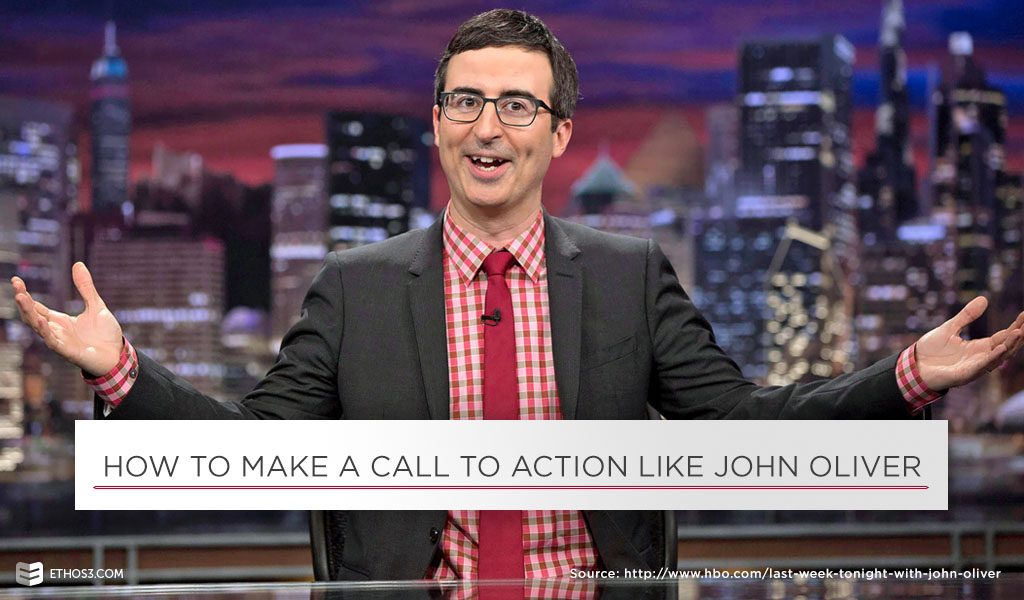Calls to action are an important part of the presentation process. With a few exceptions, the majority of presentations should ask the audience to do something that will further spread the message. Take John Oliver’s show Last Week Tonight for example. Each Sunday night, Oliver explains a problem facing the nation or the world, and discusses possible solutions. On May 7th, Oliver talked about net neutrality.
This was not the first time Oliver discussed keeping the internet open and free for all users. On June 1st, 2014, Oliver first introduced the concept of net neutrality and his argument for it.
In both instances, Oliver established an impassioned call to action. He urged his viewers to leave comments on the Federal Communications Commission’s website, expressing their personal views on net neutrality. On both instances, the website received thousands of comments. On the first instance, the FCC’s website crashed because of the amount of responses. On May 14th, Oliver discussed net neutrality again, giving instructions to his audience on what to do now that the FCC is about to vote on the topic.
Let’s take a deeper look at how to make a call to action like John Oliver:

Make the Process Simple:
The most effective action Oliver takes is making the call to action simple for his audience. As he describes in his May 7th episode, there are many steps a person has to take just to get to the comment section of the FCC’s website. Instead of expecting his audience to follow through with the series of steps, Oliver created a landing page that bypasses everything and takes the viewer straight to the comment section.
This is highly effective because it increases the chances of your audience actually following through with the call to action. By telling your audience how you made the process easier for them on your own accord, you are also showing them how much you want them to act on a message that you are passionate about.
Be Passionate:
Oliver didn’t just sit behind his desk when he asked for his audience to act on net neutrality; he got up, walked towards the camera, and spoke passionately about why it is important to act. This shows how much Oliver cares about the topic he is presenting and how badly he wants to see his audience react.
Don’t hold back on showing your audience how passionate you are about your message. Showing emotion is a way to connect with your audience and leave a lasting impression. When you reach the call to action part of your presentation, try walking around the stage and engaging with your audience to prove to them how much you want them to act. This may be the only opportunity you get to share your message in front of a crowd, so make sure your call to action is the most energizing moment you share with your audience.
Don’t Abandon Your Message:
There have been three instances now that Oliver has dedicated time on his show to net neutrality. Each time, he explains what is going on and the dangers and challenges it faces. And each time, he urges his audience to act. With his latest comment on the issue on May 14th, he addresses the problems his call to action caused; he instructs his audience on how to be even more effective in their fight for net neutrality. Did Oliver have to make another video addressing the problem? No, because his first two calls to action generated thousands of comments. But because Oliver feels strongly about this ongoing issue, he wants to make sure the quality of his responses was legitimate.
Just because you make a call to action in your presentation does not mean your job is done. You need to follow up and find a way to keep track of your responses. For example, you can create a hashtag and ask your audience to use it when they have completed their call to action. Or you can track how many people have gone to your landing page with features like the ones on HubSpot. Keep promoting your cause as long as you support it, to ensure that your message will stand the test of time.
Make a strong call to action to get your message spread across various platforms. Follow up on your call to action to establish trust with your audience. With the FCC taking votes on net neutrality in the coming weeks, John Oliver’s audience can trust that he will cover the outcome.
More from the Ethos3 Blog:
Make the Best Call to Action of All Time
How to Give an Effective Call to Action
Why Every Presentation Needs a Call to Action
Try One of These Words in Your Next Presentation Call to Action
